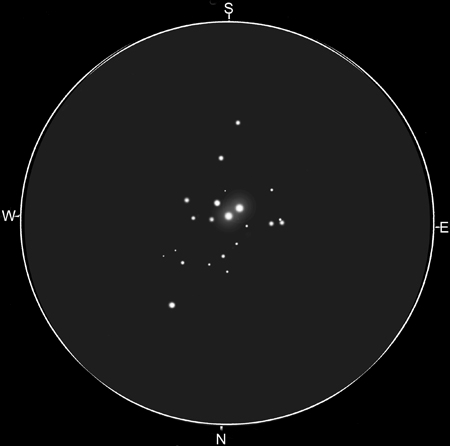March 2016 - Double Star of the Month
STF 485/STF 484 (04 07 51.38 +62 19 45.4) are really just part of the open cluster NGC 1502 (H VII 47).

For the small telescope user this is a pretty sight but its appears to be a real headache for the double star cataloguers and there is an extensive entry in the WDS catalogue notes trying to sort out which stars are which, and who discovered what.
The brightest pair is STF 485 AE which consists of stars of mags 6.91 and 6.94 separated by 17". There are a further 5 comites of magnitude 10 or brighter within 140" of star A. Two of these, mags 9.63 and 9.81, form STF 484 at 336° and 22".8 (visible on the drawing to the east of the cluster centre). Recently, Andrè Debackére measured a new component in one of the pairs in this group (see DSSC 24 on this website).
For the astrophysicist, the most interesting star is E. This turns out to be a multiple star consisting of a 2.69 day Algol system with a third star (but also a close binary) 0".1 distant circling the two every 54 years. The total mass in this system is more than 50 suns. The GCVS gives the name SZ Cam to the variable but ironically the distance derived from the dynamics of the 54-year system place the stars over 300 pc further than the accepted distance of 800 pcs to the cluster. There is little colour in this grouping as many of the components are hot early B stars.
15 Hya (08 51 34.44 -07 10 38.0) is an object which I have not yet observed but which in terms of separation and magnitude difference looks like a tempting target.
The star first entered the double star catalogues as H V 120 when William Herschel noted on 1782 Dec 28 that it appeared Extremely unequal
with the brighter star white and the comes red whilst the separation was 43 arc seconds.
The WDS gives magnitude 11.4 for the fainter star but relegates it to component C as in 1878 S. W. Burnham found that the primary was a close double (0".47) whose components he estimated had magnitudes 5.7 and 7.2. Since then the close pair has widened significantly and is now more than 1" apart so it should be visible in 15-cm in the UK; the seeing needs to be good as the declination counts against it.
Burnham adds a further faint star of mag 12.1 at 55". AB is clearly a long period binary and the position angle has decreased to 121 degrees in 2003 although there do not appear to have been any measures since then.
Bob Argyle - Double Star Section Director
We have had an observation submitted for STF 485. If you have observed this double star – or the cluster it is in – please let us know.